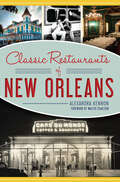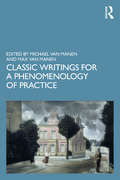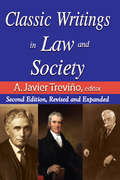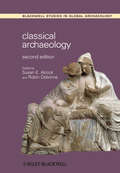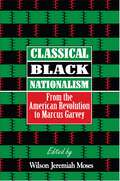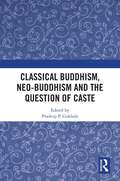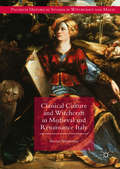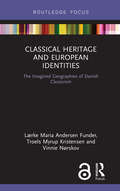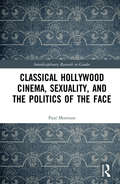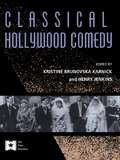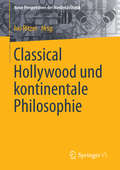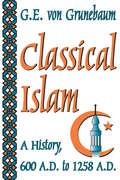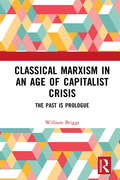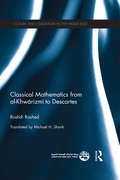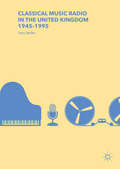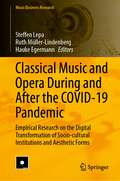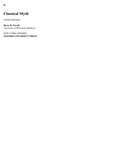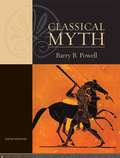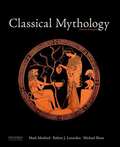- Table View
- List View
Classic Restaurants of New Orleans (American Palate)
by Alexandra KennonA culinary history of some of the Crescent City&’s best restaurants through the years, featuring delicious recipes you can make at home.Every New Orleanian knows Leah Chase&’s gumbo, but few realize that the Freedom Fighters gathered and strategized over bowls of that very dish. Or that Parkway&’s roast beef po-boy originated in a streetcar conductors&’ strike. In a town where Antoine&’s Oysters Rockefeller is still served up by the founder&’s great-great-grandson, discover the chefs and restaurateurs who kept their gas flames burning through the Great Depression and Hurricane Katrina. Author Alexandra Kennon weaves the classic offerings of Creole grande dames together with contemporary neighborhood staples for a guide through the Crescent City's culinary soul. From Brennan&’s Bananas Foster to Galatoire&’s Soufflé Potatoes, this collection also features a recipe from each restaurant, allowing readers to replicate iconic New Orleans cuisine at home.&“I tip my toque to Alex Kennon for a captivating walk through New Orleans&’ restaurant history—from the owners who preserved these houses of gastronomy to the legendary chefs who managed taste and flavor. As reflected through these pages, the Crescent City feeds the soul like no other place on the globe.&” —Chef John D. Folse, Louisiana&’s culinary ambassador to the world&“The roux-spattered archives of Antoine&’s, Arnaud&’s, Parkway Bakery and Tavern, and other heavyweights are crammed with anecdotes, not to mention recipes, but that&’s where Kennon&’s highly unusual CV comes in. The editor/entertainer sifts through a century and a half of culinary histories to craft a compelling narrative rife with colorful traditions . . . Just as valuable are her expansive conversations with owners, chefs, bartenders, and oyster shuckers alike as they tote weighty reputations and make delicate changes with another century of success in mind.&” —Country Roads Magazine &“Within its pages, Kennon explores what it&’s like to be part of the process of creating the thousands of memorable meals that have been served at some of the most beloved (and mostly family-run) restaurants over the decades.&” —The Advocate
Classic Writings for a Phenomenology of Practice (Phenomenology of Practice)
by Michael van Manen; Max van ManenClassic Writings for a Phenomenology of Practice features examples of newly translated classic phenomenological texts that have been largely forgotten or misunderstood. The writings are unique in that they speak to the practice of doing phenomenological research for the purpose of gaining insights and better understandings regarding aspects of professional practice and ordinary life phenomena and events. Phenomenology does not have to be impenetrable philosophy, dealing with tedious technical issues. Instead, phenomenology may offer relevance, value, and enduring allure to readers and researchers who are engaged with the quotidian life experiences and events of students, patients, clients, friends, and other individuals. This phenomenological approach aims to stay as close as possible to the ordinary events of everyday life: seeing the first smile of a child, feeling compulsive, being humorous, having a conversation, experiencing childhood secrecy, encountering new things—topics that span a manifold of life experiences. In this collection of classic phenomenological writings, each author is thoughtfully introduced, and each text is followed by a conversational descant: a reflection on the phenomenological reflection. The presentation of these classic writings and their reflections aims to show us what it means to do phenomenology directly on the phenomena that we live—thus asking us to be attentive to the fascinating varieties and subtleties of primal lived experiences and consciousness in all its remarkable complexities. This book is relevant for scholars and students who are interested in human science research and the origins and practices of the phenomenological method.
Classic Writings in Law and Society: Contemporary Comments and Criticisms
by A. Javier TreviñoThis volume consists of outstanding essays by contemporary scholars and specialists on classic writings in law and society. This second edition expands the previous volume by adding additional statements. Included are commentaries on Edward A. Ross's Social Control: A Survey of the Foundations of Order, Karl N. Llewellyn's Jurisprudence: Realism in Theory and Practice, Jerome Frank's Law and the Modern Mind, Leon Petrazycki's Law and Morality, and Karl Renner's The Institutions of Private Law and their Social Functions.The goal of Classic Writings in Law and Society is to acquaint a new generation of students with classic writings by diverse social and legal scholars ranging from Henry Sumner Maine, Oliver Wendell Holmes, Jr., and Hans Kelsen to Eugen Ehrlich, Nicholas S. Timasheff, and Richard Quinney. This work continues to demonstrate their contemporary theoretical relevance. Accordingly, each chapter speaks of the scholars' work in general, how the particular book under consideration fits into that corpus, and how the book is assessed in a present day context. These essays have a clear relation to the "classic" tradition in sociolegal thought.Reading the classics is useful in gaining a better understanding and appreciation of the essential foundation for a post-classic approach in law and social inquiry an approach that can be found in such orientations as critical legal studies, chaos theory in law, and legal semiotics. Classic Writings in Law and Society includes commentaries that consider early writings that set the standard for the social scientific approach in examining issues of law and punishment, social control, joint stock companies, business firms and nation-states in the study of law and society.
Classical Archaeology (Wiley Blackwell Studies in Global Archaeology #18)
by Robin Osborne Susan E. AlcockThe fully revised second edition of this successful volume includes updates on the latest archaeological research in all chapters, and two new essays on Greek and Roman art. It retains its unique, paired essay format, as well as key contributions from leading archaeologists and historians of the classical world. Second edition is updated and revised throughout, showcasing the latest research and fresh theoretical approaches in classical archaeology Includes brand new essays on ancient Greek and Roman art in a modern context Designed to encourage critical thinking about the interpretation of ancient material culture and the role of modern perceptions in shaping the study of art and archaeology Features paired essays – one covering the Greek world, the other, the Roman – to stimulate a dialogue not only between the two ancient cultures, but between scholars from different historiographic and methodological traditions Includes maps, chronologies, diagrams, photographs, and short editorial introductions to each chapter
Classical Black Nationalism: From the American Revolution to Marcus Garvey
by Wilson Jeremiah MosesExamines the evolution of black nationalist thought from its earliest proto-nationalistic phase in the 1700s to the Garvey movement in the 1920sRecent years have seen a resurgence of interest in modern black nationalist leaders such as Stokely Carmichael and Malcolm X. But what of the ideological precursors to these modern leaders, the writers, and leaders from whose intellectual legacy modern black nationalism emerged? Wilson Jeramiah Moses, whom the Village Voice called one of the foremost historians of black nationalism, has here collected the most influential speeches, articles, and letters that inform the intellectual underpinnings of contemporary black nationalism, returning our focus to black nationalism at its inception. The goal of early black nationalists was the return of the African-American population to Africa to create a sovereign nation-state and to formulate an ideological basis for a concept of national culture. Most early black nationalists believed that this return was directed by the hand of God. Moses examines the evolution of black nationalist thought through several phases, from its proto-nationalisic phase in the late 1700s through a hiatus in the 1830s, through its flourishing in the 1850s, its eventual eclipse in the 1870s, and its resurgence in the Garvey movement of the 1920s.Moses provides us with documents that illustrate the motivations of both whites and blacks as they sought the removal of the black population. We hear from Thomas Jefferson, who held that it was self-evident that black and white populations could not intermingle on an equal basis or merge to form one happy society, and who toyed with the idea of a mass deportation of the black American population. We see that the profit motive is an important motive behind any nationalist movement in the letters between African American capitalists Paul Cuffe and James Forten. Among the more difficult selections to classify in this collection, Robert Alexander Young's Ethiopian Manifesto prophesied the coming of a prophetic liberator of the African race. The Christian nature of nineteenth century black nationalism is evident in Blyden's The Call of Providence.Moses rounds out the volume with contributions from more well- known voices such as those of Marcus Garvey, W.E.B. Dubois, and others. Classical Black Nationalism will serve as a point of departure for anyone interested in gaining a foundational knowledge of the disparate voices behind this often discussed but seldom understood movement.
Classical Buddhism, Neo-Buddhism and the Question of Caste
by Pradeep P. GokhaleThis book examines the interface between Buddhism and the caste system in India. It discusses how Buddhism in different stages, from its early period to contemporary forms—Theravāda, Mahāyāna, Tantrayāna and Navayāna—dealt with the question of caste. It also traces the intersections between the problem of caste with those of class and gender. The volume reflects on the interaction between Hinduism and Buddhism: it looks at critiques of caste in the classical Buddhist tradition while simultaneously drawing attention to the radical challenge posed by Dr B. R. Ambedkar’s Navayāna Buddhism or neo-Buddhism. The essays in the book further compare approaches to varṇa and caste developed by modern thinkers such as M. K. Gandhi and S. Radhakrishnan with Ambedkar’s criticisms and his departures from mainstream appraisals. With its interdisciplinary methodology, combining insights from literature, philosophy, political science and sociology, the volume explores contemporary critiques of caste from the perspective of Buddhism and its historical context. By analyzing religion through the lens of caste and gender, it also forays into the complex relationship between religion and politics, while offering a rigorous study of the textual tradition of Buddhism in India. This book will be useful to scholars and researchers of Indian philosophy, Buddhist studies, Indology, literature (especially Sanskrit and Pāli), exclusion and discrimination studies, history, political studies, women studies, sociology, and South Asian studies.
Classical Civilizations of South-East Asia
by Vladimir BraginskyWith particular emphasis on history, religion, literature and arts, this collection provides a multifaceted and representative picture of the classical civilizations of South-East Asia which will be of interest for comparative and cross-disciplinary studies in this field, as well as providing a number of historical and literary documents and translations of great scholarly value.
Classical Culture and Witchcraft in Medieval and Renaissance Italy (Palgrave Historical Studies in Witchcraft and Magic)
by Marina MontesanoThis book explores the relationships between ancient witchcraft and its modern incarnation, and by doing so fills an important gap in the historiography. It is often noted that stories of witchcraft circulated in Greek and Latin classical texts, and that treatises dealing with witch-beliefs referenced them. Still, the role of humanistic culture and classical revival in the developing of the witch-hunts has not yet been fully researched. Marina Montesano examines Greek and Latin literature, revealing how particular features of ancient striges were carried into the Late Middle Ages, through the Renaissance and into the fifteenth century, when early Italian trials recall the myth of the strix common in ancient Latin sources and in popular memory. The final chapter also serves as a conclusion, to show how in Renaissance Italy and beyond, classical accounts of witchcraft ceased to be just stories, as they had formerly been, and were instead used to attest to the reality of witches’ powers.
Classical Heritage and European Identities: The Imagined Geographies of Danish Classicism (Critical Heritages of Europe)
by Lærke Maria Andersen Funder Troels Myrup Kristensen Vinnie NørskovClassical Heritage and European Identities examines how the heritages of classical antiquity have been used to construct European identities, and especially the concept of citizenship, in Denmark from the eighteenth century to the present day. It implements a critical historiographical perspective in line with recent work on the "reception" of classical antiquity that has stressed the dialectic relationship between past, present and future. Arguing that the continuous employment and appropriation of lassical heritages in the Danish context constitutes an interesting case of an imagined geography that is simultaneously based on both national and European identities, the book shows how Denmark’s imagined geography is naturalized through very distinctive uses of classical heritages within the educational and heritage sectors. It does so by exploring three significant and interrelated arenas where the heritages of classical antiquity are used to shape Danes as European citizens. Together, these three cases emphasize different but interconnected ways in which classical heritages are being put to use in order to construct Denmark’s own distinctive national identity within Europe. Finally, the book also sheds light on some of the challenges that face unified and homogenous conceptions of European heritage and identity, as well as the notion of the "classical" itself. Classical Heritage and European Identities is the first English-language monograph to situate the Danish case within the wider European context. As such, the book should be essential reading for researchers and students engaged in the study of heritage and museums, classics, education and modern European history.
Classical Hollywood Cinema, Sexuality, and the Politics of the Face (Interdisciplinary Research in Gender)
by Paul MorrisonClassical Hollywood Cinema, Sexuality, and the Politics of the Face examines the representation of iconic female faces in the golden age of Hollywood – Greta Garbo, Gloria Swanson, Elizabeth Taylor – and the gay male fetishization of those faces. Classical Hollywood cinema is given to an aesthetic and ideological struggle between rival scopic economies: an erotics of “to-be-looked-at-ness” is countered by a hermeneutics of “to-be-seen-through-ness.” The latter emerges triumphant, but the legendary female faces of Hollywood resist, in their different ways, a coercive and normalizing knowledge, which is the source of the gay male investment in them. A disciplinary society privileges a hermeneutics of gaze; the iconomic female faces of classical Hollywood cinema demand an erotics. Classical Holly Cinema, Sexuality, and the Politics of the Face explores the tension between the two through detailed readings of Ninotchka, Sunset Boulevard, and Suddenly, Last Summer in the context of early and mid-century cinema and culture. It includes, for instance, an analysis of D. W. Griffith and blackface, the Stonewall riots and the coming-into-voice of the modern gay subject, several major films by Hitchcock, Citizen Kane, and the emergence of rival standards of beauty, both female and male, in figures such as Katharine Hepburn, Ingrid Bergman, Humphrey Bogart, Rock Hudson, and James Dean. This is an important study for students of queer theory, film theory and history, and gender and sexuality studies.
Classical Hollywood Comedy (AFI Film Readers)
by Henry Jenkins Kristine Brunovska KarnickApplies the recent `return to history' in film studies to the genre of classical Hollywood comedy as well as broadening the definition of those works considered central in this field.
Classical Hollywood Film Cycles (Routledge Advances in Film Studies)
by Zoe WallinThis book explores the ways in which Hollywood film cycles from the 1930s to the 1960s were shaped by their surrounding industrial contexts and market environments, to build an inclusive conception of the form, operation, and function of film cycles. By foregrounding patterns of distribution, spaces of exhibition, and modes of consumption as key components of the form and mechanics of cycles, this book develops a methodology for defining cycles based on an analysis of the industry and trade discourse. Applying her unique framework to six case studies of different cycles, Zoe Wallin blends a wide range of historical sources to analyze the many cultural, social, political, aesthetic, and industrial contexts relevant to these films. This book makes an important contribution to the literature in the area of film historiography, and will be of interest to any scholars of film studies, history and media studies.
Classical Hollywood und kontinentale Philosophie (Neue Perspektiven der Medienästhetik)
by Ivo RitzerDie Autorinnen und Autoren nehmen paradigmatische Analysen von spezifischen Produktionen des Classical Hollywood aus genuin philosophischer Perspektive vor. Leitfragen weisen sie je kulturellen, generischen und/oder autorspezifischen Kontexten zu, wobei sowohl anthropologische, psychoanalytische, phänomenologische als auch poststrukturalistische Theorien der kontinentalen Philosophie den methodischen Horizont bilden. In dieser Hinsicht wird eine multiperspektivische Situierung der Untersuchungsgegenstände geleistet, um eine differenzierte Betrachtung des Systems von Classical Hollywood sicher zu stellen. Ziel ist, eine komparatistische Sicht auf unterschiedliche Genres, Filmemacher und Bildpraktiken zu ermöglichen, so dass die differenten Facetten des Classical Hollywood sichtbar werden.
Classical Islam: A History, 600 A.D. to 1258 A.D.
by G. E. von GrunebaumIn a book written with the poignancy and beauty appropriate to its subject matter, the author opens by reminding us that the essence of a society is in a sense identical with its history. Classical Islam also serves as a reminder that in the case of Islam, despite its triumphs on the fields of battle, telling its history is the only way open to us to render that essence accessible and show it from all sides. The work offers a grand narrative of a faith that offers an interpretation of the world, a way of life, and a style of thinking, that goes far beyond institutional or political supports. The relevance of this historical perspective is beyond dispute. The period from 610 A.D. when Muhammad received his call until the conquest of Baghdad by the Mongols in 1258 is known as the classical period of Islam. This was the period of the great expansion of Islam both as a political structure and as a religious and intellectual community. It established the base for the development of the high Islamic civilization of North Africa, the Near East, Persia, and India, as well as further expansion of the Islamic religious and intellectual community throughout the world. This book presents an authoritative history of the period written by one of the world's leading experts on the subject.Classical Islam examines the relationships, both cultural and political, between the Islamic world and the Mediterranean countries and India and elaborates on the economic, social, and intellectual factors and forces that shaped the Muslim world and molded its interactions with infidels. The work is written in a clear and direct narrative form, emphasizing simultaneously the major intellectual trends and the political events and tendencies of the formative period in Islamic history that still resonates today.
Classical Kids: An Activity Guide to Life in Ancient Greece and Rome
by Laurie CarlsonTravel back in time to see what life was like in ancient Greece and Rome while having fun with hands-on activities such as making a star gazer; chiseling a clay tablet; weaving Roman sandals; making a Greek mosaic; creating Roman jewelry; throwing Greek pottery; casting a vote in a Roman-style election; and much more. Learn how these civilizations contributed to our present-day world by participating in art, math, cooking, science, and geography activities. Interesting facts and trivia are included throughout. Helpful illustrations explain project steps.
Classical Marxism in an Age of Capitalist Crisis: The Past is Prologue
by William BriggsWill capitalism survive forever? Capitalism has always lived in and with crisis. Wars, revolutions, economic depression and repeated recessions, the threat of nuclear annihilation and ecological disaster have all failed to break the dominance of this economic and political system. Challenging the predominance of capitalism in a world fraught with inequalities, this book returns to classical Marxism to reaffirm its relevance. It explores the contradictions within capitalism as well as explaining why Marxism has been unable to mount a sustained challenge to capitalism. In order to explore concrete alternatives in a period of increasing capitalist globalisation and crisis, it goes on to present perspectives by which theory and practice might be reunited to building independent political and organisational structures. A search for “something better”, this volume will be an engaging read for scholars and researchers of politics, especially political theory and political economy, economics, and sociology.
Classical Mathematics from Al-Khwarizmi to Descartes (Culture and Civilization in the Middle East)
by Roshdi RashedThis book follows the development of classical mathematics and the relation between work done in the Arab and Islamic worlds and that undertaken by the likes of Descartes and Fermat. ‘Early modern,’ mathematics is a term widely used to refer to the mathematics which developed in the West during the sixteenth and seventeenth century. For many historians and philosophers this is the watershed which marks a radical departure from ‘classical mathematics,’ to more modern mathematics; heralding the arrival of algebra, geometrical algebra, and the mathematics of the continuous. In this book, Roshdi Rashed demonstrates that ‘early modern,’ mathematics is actually far more composite than previously assumed, with each branch having different traceable origins which span the millennium. Going back to the beginning of these parts, the aim of this book is to identify the concepts and practices of key figures in their development, thereby presenting a fuller reality of these mathematics. This book will be of interest to students and scholars specialising in Islamic science and mathematics, as well as to those with an interest in the more general history of science and mathematics and the transmission of ideas and culture.
Classical Music Radio in the United Kingdom, 1945–1995
by Tony StollerThis book is the first comprehensive account of classical music on all British radio stations, BBC and commercial, between 1945 and 1995. It narrates the shifting development of those services, from before the launch of the Third Programme until after the start of Classic FM, examining the output from both qualitative and quantitative perspectives, as well as recounting some of the stories and anecdotes which enliven the tale. During these fifty years, British classical music radio featured spells of broad, multi-channel classical music radio, with aspirational and mainstream culture enjoying positive interactions, followed by periods of more restricted and exclusive output, in a paradigm of the place of high culture in UK society as a whole. The history was characterised by the recurring tensions between elite and popular provision, and the interplay of demands for highbrow and middlebrow output, and also sheds new light on the continuing relevance of class in Britain. It is an important and unique resource for those studying British history in the second half of the twentieth century, as well as being a compelling and diverting account for enthusiasts for classical music radio.
Classical Music and Opera During and After the COVID-19 Pandemic: Empirical Research on the Digital Transformation of Socio-cultural Institutions and Aesthetic Forms (Music Business Research)
by Hauke Egermann Ruth Müller-Lindenberg Steffen LepaThe global COVID-19 pandemic, the resulting lockdown imposed in many countries, as well as related safety measures taken by governments and authorities, have posed significant challenges to classical music culture. However, they may also have had a stimulating effect on music festivals and opera houses’ streaming offerings. This book brings together experts from the fields of musicology and music management to share their current empirical research findings on the pandemic-evoked digital transformation of the classical music scene, addressing either the institutional or the reception perspective. Furthermore, it documents discussions with opera dramaturgs and artistic directors, as well as music managers and event producers in the classical field, to share their practical lockdown experiences and current strategies in dealing with the digital transformation of opera. In this way, the volume combines the perspective of academic researchers with that of practitioners in the field. This book is particularly useful for students and researchers in music and media management, as well as musicology. It is also intended to help practitioners from concert houses and opera management, such as dramaturges, artistic directors, marketing and communication directors.
Classical Myth
by Barry B. PowellFor decades, Classical Myth has been one of the most popular and best-selling texts for the study of classical myth. Oxford University Press is proud to publish this essential book in a vibrant new ninth edition, complemented by digital learning resources that further enhance the reader's engagement with the classical past.
Classical Myth
by Barry PowellComprehensive and scholarly, this well-designed and class-tested text presents Greek and Roman myths in a lively and easy-to-read manner. It features fresh translations, numerous illustrations (ancient and modern) of classical myths and legends, and commentary that emphasizes the anthropological, historical, religious, sociological, and economic contexts in which the myths were told. It also provides a cultural context so that students can see how mythology has influenced the world and how it continues to influence society today.
Classical Myth (6th edition)
by Barry B. PowellA text springing from a course taught at the U. of Wisconsin-Madison since around 1933 that surveys classical myth, and also the roots of Western culture, emphasizing the anthropological, historical, religious, sociological, and economic contexts in which the stories were told along with analysis and interpretation. New translations from the Hebrew, Greek, Latin, and Italian have been prepared for this volume by Herbert M. Howe. Annotation c. by Book News, Inc., Portland, Or.
Classical Mythology
by Robert J. Lenardon Michael Sham Mark MorfordBuilding on the best-selling tradition of previous editions, Classical Mythology, Eleventh Edition, is the most comprehensive survey of classical mythology available--and the first full-color textbook of its kind. <p><p>Featuring the authors' clear and extensive translations of original sources, it brings to life the myths and legends of Greece and Rome in a lucid and engaging style. <p><p>The text contains a wide variety of faithfully translated passages from Greek and Latin sources, including Homer, Hesiod, all the Homeric Hymns, Pindar, Aeschylus, Sophocles, Euripides, Herodotus, Plato, Lucian, Lucretius, Vergil, Ovid, and Seneca.
Classical Mythology (Tenth Edition)
by Mark P. O. Morford Robert J. Lenardon Michael ShamBuilding on the bestselling tradition of previous editions, Classical Mythology, Tenth Edition, is the most comprehensive survey of classical mythology available--and the first full-color textbook of its kind. Featuring the authors' clear and extensive translations of original sources, it brings to life the myths and legends of Greece and Rome in a lucid and engaging style. The text contains a wide variety of faithfully translated passages from Greek and Latin sources, including Homer, Hesiod, all the Homeric Hymns, Pindar, Aeschylus, Sophocles, Euripides, Herodotus, Plato, Lucian, Lucretius, Vergil, Ovid, and Seneca. Acclaimed authors Mark P. O. Morford, Robert J. Lenardon, and Michael Sham incorporate a dynamic combination of poetic narratives and enlightening commentary to make the myths come alive for students. Offering historical and cultural background on the myths (including evidence from art and archaeology) they also provide ample interpretative material and examine the enduring survival of classical mythology and its influence in the fields of art, literature, music, dance, and film.
Classical Mythology A to Z: An Encyclopedia of Gods & Goddesses, Heroes & Heroines, Nymphs, Spirits, Monsters, and Places
by Annette GieseckeAn encyclopedic A-to-Z guide, this beautifully illustrated volume offers hundreds of rich, fascinating definitions of 700 major and minor characters, creatures, and places of classical mythology. Classical Mythology A-to-Z is a comprehensive and engrossing guide to Greek and Roman mythology. Written by Annette Giesecke, PhD, Professor of Classics and Chair of Ancient Greek and Roman Studies at the University of Delaware, this brilliant reference offers clear explanations of every character and locale, and captures the essence of these timeless tales.From the gods and goddesses of Mount Olympus and the heroes of the Trojan War to the nymphs, monsters, and other mythical creatures that populate these ancient stories, Giesecke recounts, with clarity and energy, the details of more than 700 characters and places. Each definition includes cross-references to related characters, locations, and myths, as well their equivalent in Roman mythology and cult.In addition to being an important standalone work, Classical Mythology A-to-Z is also written, designed, and illustrated to serve as an essential companion to the bestselling illustrated 75th-anniversary edition of Mythology by Edith Hamilton, including 10 full-color plates and 2-color illustrations throughout by artist Jim Tierney.
